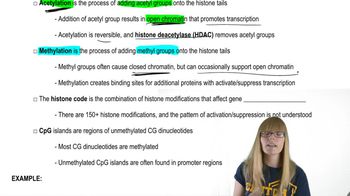- 1. Introduction to Genetics51m
- 2. Mendel's Laws of Inheritance3h 37m
- 3. Extensions to Mendelian Inheritance2h 41m
- 4. Genetic Mapping and Linkage2h 28m
- 5. Genetics of Bacteria and Viruses1h 21m
- 6. Chromosomal Variation1h 48m
- 7. DNA and Chromosome Structure56m
- 8. DNA Replication1h 10m
- 9. Mitosis and Meiosis1h 34m
- 10. Transcription1h 0m
- 11. Translation58m
- 12. Gene Regulation in Prokaryotes1h 19m
- 13. Gene Regulation in Eukaryotes44m
- 14. Genetic Control of Development44m
- 15. Genomes and Genomics1h 50m
- 16. Transposable Elements47m
- 17. Mutation, Repair, and Recombination1h 6m
- 18. Molecular Genetic Tools19m
- 19. Cancer Genetics29m
- 20. Quantitative Genetics1h 26m
- 21. Population Genetics50m
- 22. Evolutionary Genetics29m
DNA methylation is commonly associated with a reduction of transcription. The following data come from a study of the impact of the location and extent of DNA methylation on gene activity in eukaryotic cells. A bacterial gene, luciferase, was inserted into plasmids next to eukaryotic promoter fragments. CpG sequences, either within the promoter and coding sequence (transcription unit) or outside of the transcription unit, were methylated to various degrees, in vitro. The chimeric plasmids were then introduced into cultured cells, and luciferase activity was assayed. These data compare the degree of expression of luciferase with differences in the location of DNA methylation [Irvine et al. (2002). Mol. and Cell. Biol. 22:6689–6696]. What general conclusions can be drawn from these data?

 Verified Solution
Verified Solution


